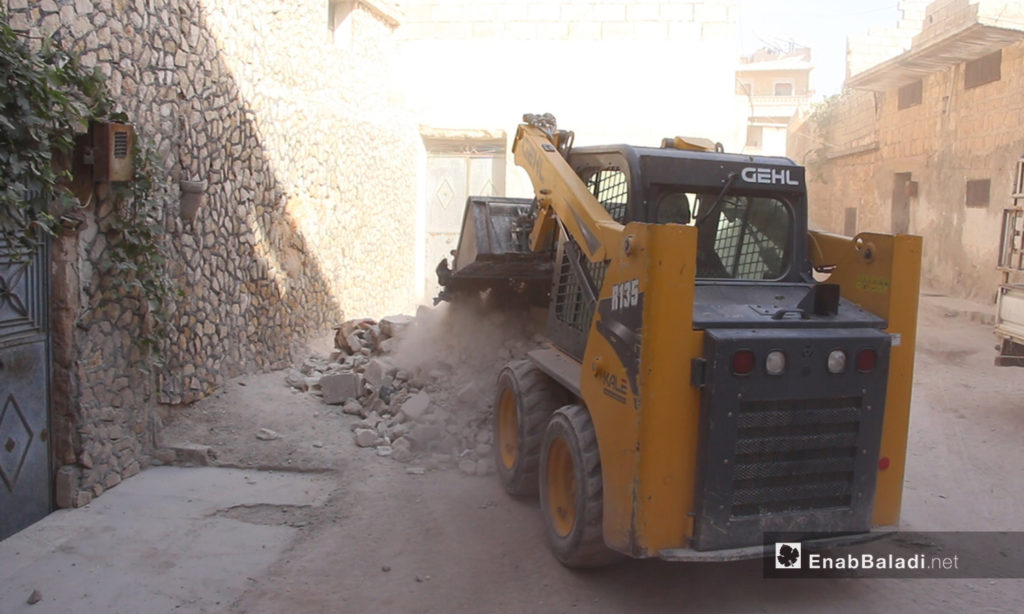Enab Baladi / Youssef Gharibi
In the western countryside of Aleppo, Najib Bakour stands watching the rubble removal machines of Syria’s Civil Defense (SCD) while working on removing a pile of stones and iron that has cut a seconday road within the town of Atarib for seven months.
Ten non-profit organizations have cooperated with activists and local public figures to launch the “Revive Atarib” initiative in the town, buried under beneath the rubble in the wake of bombings and a military campaign stalled since last March.
The 30-year-old Najib Bakour, the director of the SCD center in Atarib, told Enab Baladi. “It is a community service initiative that aims to revive life to the afflicted town of Atarib, giving it a little more beauty and radiance,” as he put it.
Emergency Committee starts work
The community-based initiative could not launch out its activities before holding training programs and meetings to discuss and identify the needs of Atarib town and its residents. This is due to the intensified military campaign conducted by the Syrian regime and its ally, Russia, on the northern countryside of Hama, the southern countryside of Idlib, the western countryside of Aleppo between December 2019 and last March, which ended by a ceasefire agreement signed between the guarantor countries Turkey and Russia.
The displacement of Atarib’s residents, many of whom had to flee the bombing on foot, did not interrupt those meetings, the coordinator of the “Local Councils Unit” in Atarib, Muhammad al-Ibrahim, told Enab Baladi.
Al-Ibrahim added, “ Meetings had lasted on social media platforms. The meetings resulted in qualifying the initiative members to attend training sessions about project management, financing governance processes, and rational management.”
Those meetings also resulted in the establishement of an Emergency Committee (EC) whose task is to “manage the town during crises and disasters.”
The EC consisted of “Atarib Hospital, Be Free Association, Civil Center, Youth Forum, Women’s Union, Women’s Authority, Syria’s Civil Defence,” as well as local public figures, and activists (who were the supervisors to start the initiative’s activities.)
These activities include removing rubble, restoring the medical center and the SCD center, and repairing street lighting poles “to reduce thefts and make people feel safe at night,” according to al-Ibrahim, adding that the EC will work to spread awareness about the novel coronavirus (COVID-19) and its hazards by distributing awareness boards and leaflets in public places.
Moving the rubble, which closed the roads and impeded the residents’ lives in the town, was not the only step taken to “revive Atarib,” as Najib Bakour said.
Bakour pointed out that debris removal of destroyed buildings will not last for more than five days, and the collected debris of the devastated buildings are given to their owners. The owners can benefit from the debris in reconstructing a new house, or they might be used to lay new roads or fill the town’s dangerous potholes.
A member of the Women’s Union, Khadija al-Abdullah, told Enab Baladi that the expected implementation period for these activities is 60 days, of which about 90 percent have been completed so far, describing these services as “useful to create a positive change in Atarib.”
What does Atarib need?
Despite the “lack of stability,” Ahmad Obeid preferred to return to his hometown because the decision to return was “the best of a lot of bad options” for him and for more than 51,000 people who have chosen to live in Atarib, according to estimates of Atarib’s local council.
The problems encountered by Obeid included the lack of electricity and water in addition to the weak trade performance (lack of selling and buying processes). Yet, he is optimistic about the “Revive Atarib” initiative, describing the community activists’ efforts to conduct the initiative as “excellent.”
“Atarib’s residents need access to electricity and water services. They want Atarib’s roads paved, buildings restored, and many public services,” as estimated by Bakour.
Nonetheless, according to al-Ibrahim, “ To encourage the population to return to their town was among the main goals of the initiative.
Atarib is only four kilometers (2.4 miles) from the Syrian regime forces. It is considered a “front line” and “uninhabitable,” according to Bakour’s description, “but because of the dire living conditions in the displacement camps and the poverty of the people, people are forced to return to their town.”
The number of returnees to Atarib has increased over the past months, according to the United Nations Office for the Coordination of Humanitarian Affairs (OCHA).
OCHA stated in its recent assessment about the numbers of displaced people returning to their villages and cities that the incentives for their return are “mostly economic.”
OCHA announced that the immense humanitarian needs in the area will persist, given the preceding months of violence and large-scale displacement. Many services in their areas were suspended or relocated.

